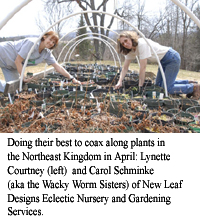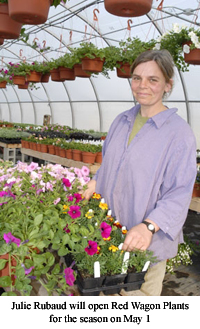
Your Garden - Designing for Taste and BeautyBy Carrie Chandler
Vermont has a rich history of farming, and today's gardeners are carrying on that tradition throughout the state, from the Intervale in Burlington to the Two Rivers Center in Montpelier to backyards everywhere. Although no numbers exist for the state, Bruce Butterfield of the National Gardening Association, based in South Burlington, notes that one "long-term tradition in Vermont is food gardening, more than in any other New England state." Vermonters are also growing more traditional gardens with hardy perennials, he says. "Another trend that is encouraging is that even if people don't grow gardens, they go to a farmers market, and support local farms." In 2006, three out of four houses in the U.S. participated in lawn and gardening activities. One out of three households grew flowers to adorn their yard, and one out of two households participated in vegetable gardening. "The numbers may be a tad higher in Vermont, because some of those houses are condominiums or apartments, but Vermont has more single family homes than other states," notes Butterfield. Julie Rubaud, owner of Red Wagon Plants, a greenhouse in Shelburne that specializes in seedlings, also feels that gardeners in Vermont are an increasing population. "My business grows easily 20 percent a year," says Rubaud. "Community gardening is exploding. People want to have a little plot even if they live in town." She attributes the growing interest to Vermont's cold climate. "Getting outside and growing beautiful plants helps feed the soul," she says. "Gardening is an antidote to our hectic digital lives. I don't know of anything else that can create a sense of wellbeing for all ages and sensibilities."
But that is not the only reason that Vermonters are breaking out their gardening gloves, according to Rubaud. "There is also the food security component, which causes a growing interest in local foods." The growing season in Vermont makes it difficult to rely on foods from your backyard year round, but Rubaud believes that gardening is shifting to focus on season extension and food storage. "Not so long ago, people were growing all of their food here," she notes. Lynette Courtney, of New Leaf Designs Eclectic Nursery and Gardening Services (www.downtoearthwormfarmvt.com), a firm that focuses on garden design in Greensboro Bend, notes that gardening helps us be better stewards of the world around us. "The pride in knowing you produced a huge pumpkin or beautiful gladiolas helps you be more protective of the land around you," she says. But the best part of gardening, according to Courtney, is that "you're putting your energy into plants that you will eat, bring into your house, or share with others. You get to be in the natural cycles of life, to be a part of the circle." Becoming a part of the circle isn't difficult, but you do have to have knowledge of what it takes to make a garden. The prospect of designing a garden stops many would-be gardeners in their tracks, but when asked, local gardeners and farmers are usually happy to share their knowledge. "The first thing you have to think about is the site of the garden," said Rubaud. Gardens rely on good drainage and sunlight. Find a place in your yard that gets sun all day. Soil also plays a role in how well your plants will grow. After finding a site, Rubaud recommends removing all the sod and improving the soil with compost, especially in a first-year garden. (For tips on creating your own compost, see Vermont Woman, April 2007). "The most important thing of all is preparing the soil. You want to make a nice bed for your new baby," agrees Courtney. "If you have healthy soil, you are guaranteed to have a healthy garden." She also recommends using compost, either from your own backyard or a local garden center. After the site is chosen, the gardener needs to decide what to put there. Part of that decision must be based on Vermont's unique growing seasons. "You can grow three gardens," says Rubaud, citing spring, summer, and autumn as three separate growing seasons. "If you work with these three seasons, you can harvest continually from May to August." Knowing your seasons will help you determine which plants can be planted, and when, but you also have to learn about the plants. "Know your plant enough to know that you are putting it in the right environment," says Courtney. "You really need to do research and consider things like wind and sunlight. Find out what your plants really want." Knowing plants' growth rates can ensure a continuous harvest. "You can be planting things every week if you want to - it's a question of knowing the pace," says Rubaud. "Each plant has a pace, either weekly, biweekly, or monthly." The possibilities for plants are endless, and you can either start them from seed at home or (for the impatient or horticulturally challenged) purchase seedlings. The key to starting them at home is good lighting, and many people utilize grow lamps, Courtney noted. If worrying about site selection and soil preparation isn't for you, there is another option. "There are all sorts of simpler things to do - raised beds, container gardens. With these, you don't always have to have conditions that are ideal," says Rubaud. "You can always do something with what you have." "You can experiment, you can do anything you want to," Courtney says. "There's something for everybody." For help in designing a vegetable or floral garden, Butterfield suggests visiting local garden centers. "You are doomed to fail if you are only looking at gardening magazines," he says. Rubaud recommends talking to farmers at the local farmers market. "Ask a farmer how often he plants his beans if you want to know how to keep beans growing all season." The University of Vermont's Extension Master Gardeners Program is another source of information for the home gardener, says Courtney. Trained gardeners can come to you, or you can call their gardening hotline for information. Whatever you decide to do, all gardens require time and effort, especially in Vermont. "You have to be scrappy to grow gardens in Vermont," says Rubaud. But, "If you take the time at the beginning to give it a good start, you will have success." Carrie Chandler is a freelance writer living in Barre. She hopes to start her first garden this spring. Photos: Margaret |

